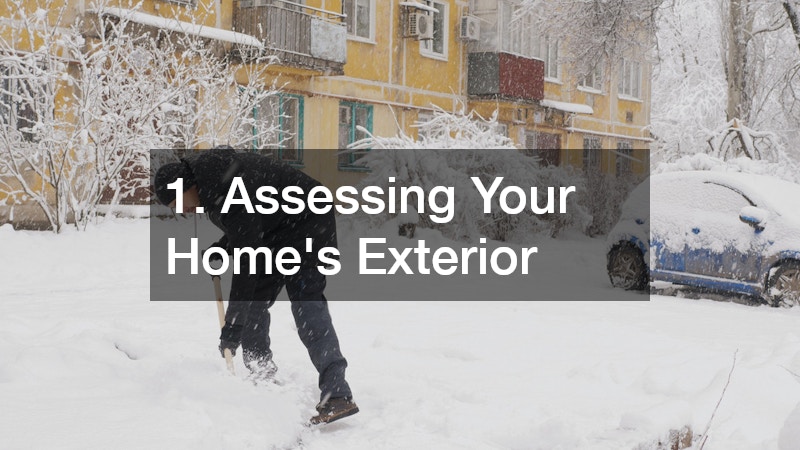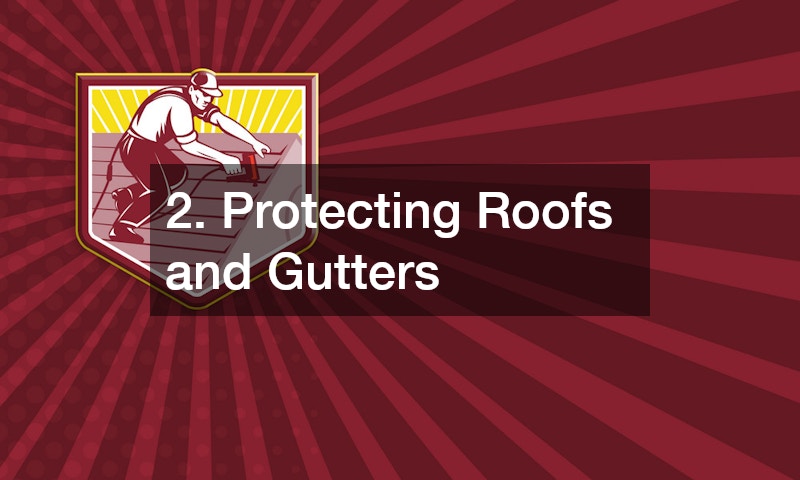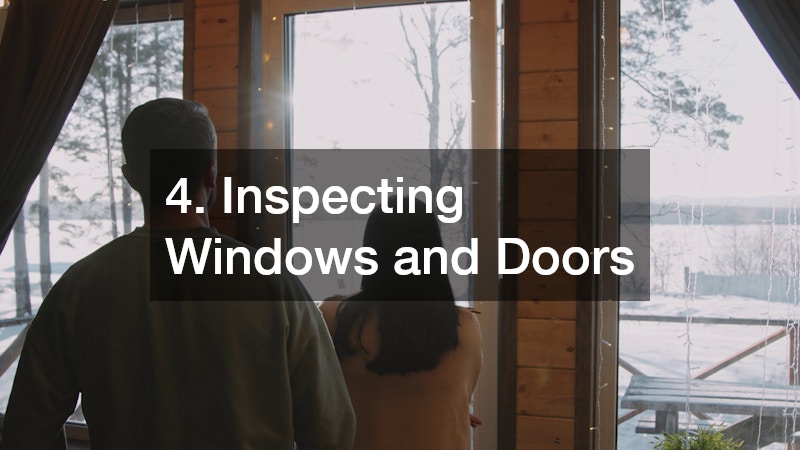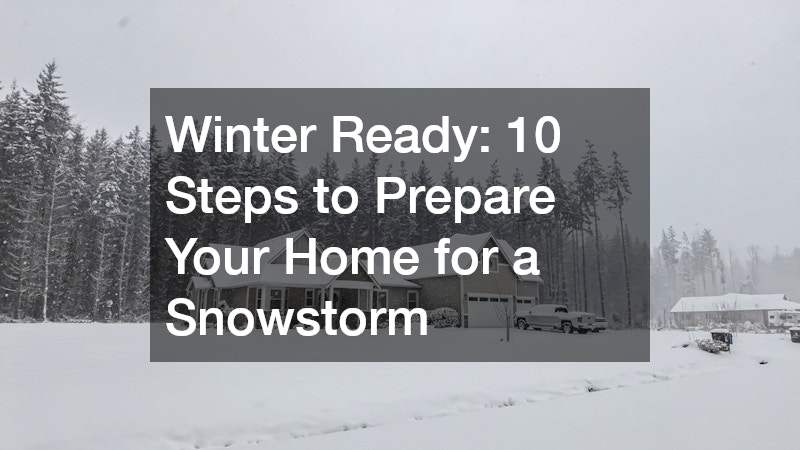Winter can be beautiful, with snow blanketing the neighborhood and twinkling lights reflecting off icy surfaces. But as magical as it looks, snowstorms can also be tough on your home. Preparing early is key to staying safe, comfortable, and stress-free during the colder months. Here’s a complete guide to getting your home winter-ready.
1. Assessing Your Home’s Exterior

Before winter weather rolls in, your home’s exterior deserves a close look. Snow and ice can magnify even the smallest issues—so catching them early is your best defense. Here’s how to make sure your home’s outer shell is ready for whatever winter brings.
Walk the Perimeter
Start with a simple walk-around inspection. Take note of any visible wear and tear that could worsen in freezing conditions. You don’t need special tools—just a careful eye and maybe a flashlight if you’re checking shaded or lower areas.
Look for:
-
Cracks or damage in siding or foundation walls
-
Gaps around windows, doors, or vents
-
Peeling paint or deteriorating caulking
-
Areas where water tends to pool near the foundation
It’s amazing how quickly a little moisture can turn into a big issue once it freezes. Addressing these small fixes now keeps your home sealed tight against drafts and leaks later.
Inspect Surfaces and Walkways
Don’t forget the areas you walk or drive on. Driveways, steps, and walkways can become slick traps once they’re covered in snow and ice. Inspect for cracks, uneven surfaces, or loose pavers that could cause tripping hazards or worsen during freeze–thaw cycles.
If needed, make simple repairs such as:
-
Filling small cracks with patching compound
-
Re-leveling sunken pavers
-
Applying a sealant before temperatures drop
A well-maintained surface makes snow removal easier and keeps everyone safer during the storm season.
Check Drainage and Grading
Proper drainage is key to preventing ice buildup and water intrusion. Make sure the soil around your home slopes slightly away from the foundation so melting snow doesn’t pool near your walls.
Also, check:
-
Downspout extensions—ensure they direct water several feet away from the house
-
Landscape edging or barriers that might trap water
-
Low spots that could collect runoff and refreeze
Taking time to redirect water now can save you from frozen ground issues and possible foundation cracks later.
Review Outdoor Fixtures and Accessories
Lastly, inspect anything attached to or placed near your home’s exterior. Loose shutters, decorative lights, or mailboxes can become damaged or even dangerous in high winds or heavy snowfall.
Take a moment to:
-
Tighten or remove loose decorations
-
Check exterior light fixtures for stability
-
Store lightweight furniture or planters indoors
A few small preventive steps will help keep your exterior clean, secure, and ready for whatever winter throws its way.
2. Protecting Roofs and Gutters

Your roof and gutters take the brunt of winter weather. Snow, ice, and freezing temperatures can put major stress on them, leading to leaks, water damage, or even structural problems if left unchecked. Taking time to prepare both systems before the first big storm is one of the smartest steps you can take to protect your home.
Inspect Your Roof Before the Snow Hits
Start by giving your roof a thorough visual inspection from the ground. Look for any signs of wear and tear that could become bigger issues once the snow piles up.
Check for:
-
Missing or loose shingles
-
Cracked or curling roofing materials
-
Damaged or rusted flashing around chimneys and vents
-
Areas where water tends to pool or drain slowly
If anything looks questionable, it’s best to handle repairs right away rather than waiting until temperatures drop. A solid roof means fewer leaks, drafts, and worries once winter storms roll through.
Clear Debris and Maintain Drainage
Fallen leaves, pine needles, and small branches can clog your roof’s drainage paths. Before winter arrives, sweep away any debris and make sure valleys and eaves are clear so melting snow can flow freely.
A blocked roof valley or clogged downspout can lead to standing water, which freezes and creates heavy ice buildup. The added weight can strain your roof and gutters, increasing the risk of damage during a snowstorm.
Clean and Inspect Gutters Thoroughly
Your gutters play a vital role in keeping water away from your home’s foundation. When they’re clogged, melting snow has nowhere to go, causing water to back up under shingles and form ice dams.
Make sure to:
-
Remove all leaves and debris from gutters and downspouts
-
Check that downspouts extend several feet away from your home
-
Inspect for loose fasteners or sagging sections
-
Test water flow with a hose before the temperature drops
If you’re not comfortable tackling this yourself, professional gutter services can handle the job safely and ensure your system is ready for winter. This simple maintenance task can prevent thousands of dollars in water damage.
Prevent Ice Dams Before They Form
Ice dams form when heat escapes through the roof, melting the snow that then refreezes near the edges. This cycle traps water and forces it under shingles, leading to leaks inside your home.
To help prevent ice dams:
-
Keep attic insulation and ventilation in good condition
-
Seal gaps where warm air escapes into the attic
-
Use a roof rake to safely remove excess snow after storms
Proactive care now can save you the headache of dealing with leaks and water stains later in the season.
3. Securing Trees and Landscaping
Snow and ice may look beautiful when they blanket your yard, but they can also cause serious damage to trees, shrubs, and outdoor structures. Preparing your landscape before winter helps protect your property and reduces the risk of falling branches or wind-blown debris.
Inspect Trees for Weak or Overhanging Branches
Start by walking around your property to check the condition of your trees. Look for branches that hang too close to your home, driveway, or power lines—these are the most likely to cause problems when loaded with heavy snow.
Signs of trouble include:
-
Cracked or split branches
-
Dead limbs with no new growth
-
Branches leaning heavily to one side
-
Trees with fungus or hollow trunks
If you spot anything that looks unstable, consider contacting a tree removal company to safely handle large or hazardous limbs. They have the right tools and experience to prevent accidents before winter storms arrive.
Trim and Maintain Healthy Growth
A bit of trimming can go a long way in protecting your trees and landscaping from storm damage. Regular pruning helps remove weak spots and allows trees to better withstand the weight of snow and ice.
When trimming:
-
Cut back branches that hang over roofs or fences
-
Thin out dense areas so snow doesn’t pile up
-
Avoid cutting too close to the trunk, which can cause stress to the tree
If you’re unsure where to start, local tree services can inspect your property and recommend the best approach to keep your trees strong and balanced throughout the season.
Secure Outdoor Furniture and Decorations
Even lightweight items can become dangerous projectiles during strong winds or blizzards. Before the first storm hits, take time to secure or store your outdoor belongings.
Here’s a quick checklist:
-
Store patio furniture, garden tools, and planters in a shed or garage
-
Tie down larger items like benches or gazebos with sturdy straps
-
Protect fragile garden ornaments by wrapping or moving them indoors
A few minutes of preparation can prevent broken decorations or damaged property once the weather turns harsh.
Protect Shrubs and Garden Beds
Shrubs and smaller plants can also suffer in freezing conditions. To protect them:
-
Cover delicate plants with breathable burlap or frost cloth
-
Add mulch around the base of plants to retain warmth
-
Avoid using heavy plastic covers, which trap moisture and cause rot
Taking these simple steps keeps your landscaping healthy and ready to thrive once spring returns.
4. Inspecting Windows and Doors

When winter storms hit, your windows and doors play a huge role in keeping the cold air out and the warmth in. A quick inspection before the snow starts falling can save you from chilly drafts and high heating costs later.
Check for Drafts and Air Leaks
Start by walking through your home on a breezy day and feeling around the edges of your windows and doors for cold air. Even a small draft can make your heating system work harder.
To fix air leaks:
-
Apply fresh weatherstripping around door frames
-
Seal gaps with caulk, especially around window trims
-
Use door sweeps to block air from sneaking in under doors
If you notice condensation or frost between window panes, that could mean a broken seal. In that case, consider replacing the pane or scheduling a professional inspection.
Inspect Locks, Hinges, and Frames
Loose locks, squeaky hinges, or damaged frames can all cause gaps that let in cold air. Check each window and door to ensure they open and close smoothly and fit tightly in their frames.
-
Tighten screws and lubricate hinges where needed
-
Replace worn-out latches or locks
-
For wooden frames, check for warping or rot from moisture buildup
This step isn’t just about comfort—it’s also about safety. Strong, well-sealed entries help keep both the cold and unwanted intruders out.
Don’t Forget the Garage Door
Many homeowners overlook their garage doors, but these large openings are often one of the biggest sources of heat loss in winter. Cold air can seep in through cracks or thin panels, chilling nearby rooms and increasing your energy bills.
To winterize your garage doors:
-
Check the rubber seal along the bottom and replace it if it’s cracked or brittle
-
Add insulation panels to help maintain temperature inside the garage
-
Make sure the door closes flush with the floor—adjust the tracks if necessary
If your garage is attached to your home, insulating the door makes a noticeable difference in keeping indoor temperatures stable.
Upgrade to Energy-Efficient Options
If your windows or doors are old or damaged, upgrading to energy-efficient models can pay off over time. Look for double- or triple-pane windows and insulated doors with a high energy rating.
Energy-efficient upgrades help by:
-
Reducing drafts and improving comfort
-
Lowering heating bills
-
Adding value to your home
It’s an investment that makes your home cozier and more storm-ready for many winters to come.
5. Preparing Heating Systems
When the temperature drops and snow begins to fall, a dependable heating system becomes your home’s best defense against the cold. A few proactive steps before winter arrives can help you stay warm, save money, and avoid last-minute emergencies.
Schedule a Professional Heating Inspection
Before the snow season kicks in, it’s smart to have a professional inspect your furnace, boiler, or central heating system. Annual tune-ups help catch small problems before they turn into costly breakdowns.
During an inspection, a technician will typically:
-
Clean burners and heating elements
-
Check for gas or oil leaks
-
Replace dirty filters
-
Test thermostat calibration
-
Ensure vents and exhaust lines are clear
This maintenance keeps your system efficient, reducing both energy use and the risk of midwinter malfunctions.
Replace Filters and Test the Thermostat
Dirty filters restrict airflow, making your heating system work harder than necessary. Replace or clean filters every one to three months—especially before the coldest months hit.
Next, test your thermostat to make sure it responds accurately. Try turning the heat on and off and adjusting the temperature a few degrees to confirm that the system kicks in properly. If you’re using a programmable or smart thermostat, set it to automatically lower temperatures at night or when you’re away to save on energy costs.
Check Your Fuel Supply and Delivery Options
If your home runs on heating oil, ensuring your tank is full before a snowstorm is crucial. Contact a residential oil delivery provider ahead of time to schedule a refill—especially early in the season when demand is high.
Also:
-
Inspect your oil tank for leaks or corrosion
-
Keep the fill pipe accessible and clear of snow
-
Ask about automatic delivery options to avoid running low mid-winter
Staying stocked with fuel guarantees your home remains warm and comfortable, even if the storm keeps you indoors for several days.
Prepare Backup and Supplemental Heating Sources
It’s always smart to have a secondary heat source ready in case of power outages or system issues. Wood stoves, pellet stoves, or space heaters can provide essential warmth in emergencies.
Keep these safety tips in mind:
-
Use space heaters on level surfaces and away from flammable materials
-
Check carbon monoxide detectors regularly
-
Store extra firewood or pellets in a dry, accessible area
A little foresight now ensures you’ll be ready to stay cozy and safe no matter how fierce the snowstorm gets.
6. Ensuring Backup Power and Energy Supply
Snowstorms don’t just bring cold—they often bring power outages too. Having a reliable backup plan ensures you can keep your home warm, lights on, and essential devices running, even when the grid goes down.
Evaluate Your Backup Power Options
The first step is to decide what kind of backup power makes sense for your home. While a home generator is the most robust solution, some households may rely on smaller alternatives like battery packs, portable power stations, or even solar-powered chargers.
Consider what you’ll need to keep running during an outage:
-
Heating systems or supplemental heaters
-
Refrigerators and freezers
-
Lights and communication devices
-
Medical equipment, if necessary
Knowing your power priorities helps you choose the right solution and avoid running out of juice when you need it most.
Maintain and Test Your Generator
If you have a home generator, now is the time to make sure it’s in tip-top shape. A few simple checks can prevent last-minute failures:
-
Inspect fuel lines and oil levels
-
Run the generator for a test period to ensure it starts smoothly
-
Check all electrical connections and circuit breakers
-
Ensure it’s placed in a safe, ventilated area away from doors and windows
Regular maintenance, or even scheduling professional home generator services, can extend the life of your generator and give you peace of mind before the first big storm hits.
Keep Fuel and Supplies Ready
Backup power is only as good as your fuel supply. Make sure you have enough gasoline, propane, or diesel on hand to last through an extended outage. Store fuel safely, in approved containers, and away from heat sources or living areas.
Other helpful tips:
-
Keep spare extension cords rated for outdoor use
-
Have extra batteries for flashlights and small devices
-
Consider backup charging solutions for phones and laptops
Being prepared ensures you won’t be caught off guard if snow and ice knock out the electricity for days.
Plan for Safe Usage During Outages
Even the best generator or battery system won’t help if it’s not used safely. Review safety protocols with your household:
-
Never operate generators indoors or in enclosed spaces
-
Keep flammable items away from any heat source
-
Monitor carbon monoxide detectors
-
Rotate battery backups to maintain performance
A little planning now keeps your home safe and functional, reducing stress and uncertainty during a snowstorm.
7. Protecting Plumbing and Water Systems

Winter storms can be harsh on your home’s plumbing. Frozen or burst pipes are a common problem that can lead to expensive repairs and serious water damage. Taking proactive steps now ensures your plumbing and water systems stay safe and functional throughout the cold season.
Insulate Exposed Pipes
Exposed pipes in basements, attics, crawlspaces, and garages are particularly vulnerable to freezing temperatures. A simple layer of foam pipe insulation can make a big difference.
Tips for insulating pipes:
-
Use foam sleeves or fiberglass wrap for extra protection
-
Pay special attention to pipes near exterior walls or unheated areas
-
Seal any gaps where cold air might reach the pipes
Proper insulation helps prevent costly pipe bursts and keeps your water flowing, even during extended cold snaps.
Maintain Faucets and Drains
During extreme cold, letting faucets drip slightly can keep water moving and reduce the chance of freezing. It’s also important to keep drains clear to avoid backups if pipes do freeze.
Other helpful practices include:
-
Disconnect and drain garden hoses
-
Open cabinet doors under sinks to allow warm air to circulate
-
Check for slow-draining sinks or tubs that may indicate minor clogs
These small steps can save major headaches when temperatures drop.
Know Your Emergency Procedures
Even with preparation, emergencies can happen. Make sure you know how to shut off your main water valve quickly in case of a leak or burst pipe.
Other emergency prep tips:
-
Keep contact information for emergency plumbing services handy
-
Store a wrench near the water shutoff valve for easy access
-
Know which faucets to open first to relieve pressure in the system
Being prepared reduces stress and minimizes damage if winter plumbing issues arise.
Schedule Professional Help
If you’re unsure about the condition of your plumbing or water systems, it’s wise to contact a local plumber. A professional can inspect pipes, check for leaks, and recommend preventive measures before a snowstorm hits.
In addition, consider scheduling routine water heater services to ensure your system is operating efficiently. This not only keeps your home warm but also prevents water heater failures that could leave you without hot water during freezing weather.
8. Reinforcing Critical Home Structures
Heavy snow and ice don’t just make the outside look wintery—they add weight and stress to your home’s structural components. Taking the time to inspect and reinforce key areas now can prevent costly damage later.
Check Exterior Structures for Stability
Start with decks, porches, railings, and other outdoor structures. These elements can take a beating under the weight of snow or ice accumulation.
Look for:
-
Loose railings or wobbly balusters
-
Cracked or rotting wood on decks and steps
-
Sagging support beams or posts
-
Signs of water damage or rust on metal components
Even minor repairs can prevent accidents or major structural failures when winter storms hit.
Inspect Doors and Entryways
Doors are critical for both security and insulation. Make sure that exterior doors close properly and fit tightly within their frames.
Tips for reinforcing doors:
-
Tighten hinges and replace worn weatherstripping
-
Check that locks are secure and functioning smoothly
-
Reinforce garage and side doors that may face strong winds
If you notice significant damage or weakness, a local carpenter can help reinforce or repair doors, frames, and other wooden structures safely and efficiently.
Evaluate Interior Storage and Attic Areas
Interior spaces like attics, basements, and storage rooms can also benefit from reinforcement. Snow accumulation on the roof increases weight loads that may affect ceiling joists and shelving.
Steps to reinforce interiors:
-
Ensure shelving units are properly anchored to walls
-
Store heavy items close to the floor for stability
-
Inspect ceiling joists and attic supports for cracks or sagging
Proper organization and reinforcement can prevent injuries and property damage in case of structural stress.
Plan for Preventive Maintenance
Reinforcement isn’t just about emergency fixes—it’s also about planning ahead. Regular checks and minor improvements can save you time and money in the long run.
Consider:
-
Applying protective coatings or sealants to wood surfaces
-
Replacing damaged or aging hardware before winter
-
Scheduling periodic inspections of decks, railings, and doors
Preventive care ensures your home remains strong, safe, and storm-ready throughout the season.
9. Stocking Emergency Supplies and Essentials
Being prepared for a snowstorm isn’t just about the house itself—it’s also about having the supplies you need to stay safe and comfortable while the storm passes. A little planning now can prevent unnecessary stress later.
Build a Food and Water Supply
Start by making sure you have enough sustenance for everyone in your household. Focus on items that don’t require refrigeration and are easy to prepare.
Essential items include:
-
Non-perishable food like canned goods, pasta, and rice
-
Bottled water or water jugs, enough for at least three days
-
Baby formula, pet food, or special dietary items if needed
-
Comfort items like tea, coffee, or snacks
Having a reliable food and water supply means you won’t have to venture out into dangerous weather for basic needs.
Prepare Medical and Safety Items
Emergencies can happen at any time, so keep essential health and safety items close at hand.
Items to include:
-
Prescription medications and over-the-counter pain relievers
-
First aid kit with bandages, antiseptic, and other supplies
-
Flashlights, extra batteries, and a battery-powered radio
-
Blankets, warm clothing, and hand warmers
Being ready with these supplies ensures your family can stay safe, warm, and comfortable throughout the storm.
Gather Tools and Snow Removal Equipment
Snow and ice can make walkways and driveways hazardous. Having the right tools ready helps you maintain safe access to your home.
Helpful tools include:
-
Shovels for clearing snow
-
Ice melt or sand for walkways and steps
-
Snow brush or ice scraper for vehicles
-
Snow blowers or plows if you have larger areas to clear
A well-stocked kit keeps your property safe and reduces the stress of dealing with winter conditions.
Organize and Store Supplies
Once you’ve gathered essentials, make sure they’re easy to access during a storm. Store items in a dedicated area, such as a closet, pantry, or garage, where everyone in the household knows where to find them.
Organization tips:
-
Keep an inventory checklist and rotate items as needed
-
Store heavier items lower to prevent accidents
-
Label boxes or containers for quick identification
Being organized ensures you can act quickly and efficiently when the weather turns bad.
10. Safety and Emergency Planning
Preparation isn’t just about supplies—it’s also about having a plan. Knowing what to do before and during a snowstorm can keep you and your family safe and calm.
Create an Emergency Contact List
Keep a list of important phone numbers and contacts in an easy-to-find place. Include:
-
Family members and neighbors
-
Local emergency services
-
Utility companies for power, water, and gas issues
-
Nearby shelters or warming centers
Having contacts ready reduces stress and speeds up help if you need it.
Develop a Communication Plan
Power outages or heavy snowfall can disrupt normal communication. Establish a backup plan for staying in touch with family and neighbors.
Ideas for communication:
-
Set designated check-in times with family members
-
Keep a battery-powered or hand-crank radio on hand
-
Consider walkie-talkies or charged power banks for mobile devices
Clear communication ensures everyone stays informed and connected.
Plan for Safe Movement and Checks
During heavy snowfall, moving around your property or checking on neighbors can be risky. Plan ahead to reduce danger:
-
Only go outside when necessary and wear appropriate clothing
-
Keep pathways clear and well-lit if possible
-
Check on vulnerable neighbors safely, but avoid unnecessary exposure
Being deliberate and cautious helps prevent accidents and injuries.
Review Household Emergency Procedures
Finally, make sure everyone in your home knows the plan:
-
Where emergency supplies are stored
-
How to shut off utilities if needed
-
Steps to take if snow or ice blocks exits
-
Locations of safe rooms or areas for shelter
Reviewing and practicing these procedures ensures your household remains calm, safe, and confident during winter storms.
Final Thoughts
Preparing your home for a snowstorm doesn’t have to be overwhelming. By taking the time to inspect your property, maintain critical systems, reinforce structures, and stock up on essentials, you can enjoy the beauty of winter without the stress. A little effort before the storm hits goes a long way in keeping your home safe, warm, and worry-free.

